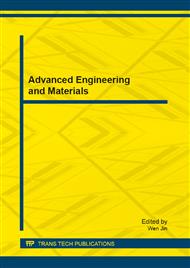[1]
B.C. Brodie, On the atomic weight of graphite, Phil. Trans. R. Soc. London. 149 (1859) 249.
Google Scholar
[2]
K. S. Novoselov, Electric field effect in atomically thin carbon films, Science. 306 (2004) 666-669.
Google Scholar
[3]
D. A. Dikin, S. Stancovich, E. J. Zimney, Preparation and characterization of graphene oxide paper, Nature. 448 (2007) 457-459.
Google Scholar
[4]
G. Eda, G. Fanchini, M. Chhowalla, Larg-area ultrathin films of reduced graphen oxide as transparent and flexible electronic material, Nature Nanotechnol. 3 (2008) 270-274.
DOI: 10.1038/nnano.2008.83
Google Scholar
[5]
X. Fan, W. Peng, Y. Li, Deoxygenation of exfoliated graphite oxide under alkaline conditions: a green route to graphene preparation, Adv. Mater. 20 (2008) 4490-4493.
DOI: 10.1002/adma.200801306
Google Scholar
[6]
D. Li, M. B. Muller, S. Gilje, Processable aqueous dispersions of graphene nanosheets, Nature Nanotech. 3 (2008) 101–105.
DOI: 10.1038/nnano.2007.451
Google Scholar
[7]
C. Xu, X. Wang, J. Zhu, Deposition of Co3O4 nanoparticles onto exfoliated graphite oxide sheets, J. Mater. Chem. 18 (2008) 5625-5629.
DOI: 10.1039/b809712g
Google Scholar
[8]
D. Cai and M. Song, Preparation of fully exfoliated graphite oxide nanoplatelets in organic solvents, J. Mater. Chem. 17 (2007) 3678-3680.
DOI: 10.1039/b705906j
Google Scholar
[9]
L. Hua, W. Kai, Y. Inoue, Synthesis and characterization of poly(ϵ-caprolactone)- graphite oxide composites, J. Appl. Polym. Sci. 106 (2007) 1880-1884.
DOI: 10.1002/app.26503
Google Scholar
[10]
H.K. Jeong, H.J. Noh, J.Y. Kim, X-ray absorption spectroscopy of graphite oxide, Europhys. Lett. 82 (2008) 67004-67008.
DOI: 10.1209/0295-5075/82/67004
Google Scholar
[11]
V. I. Saldin, A. F. Manukhin, A. K. Tsvetnikov, Synthesis and research of intercalated compounds of graphite oxide with lithium dodecahydro-closo-dodecaborate, Zh. Neorg. Khim. 38 (1993) 414-417.
DOI: 10.1002/chin.199337023
Google Scholar
[12]
V. I. Saldin, A. K. Tsvetnikov, L. N. Ignat'eva, V. M. Buznik, Intercalation of graphite oxide with dodecahydro-closo-dodecaboric acid, Russ. J. Inorg. Chem. 49 (2004) 1775-1779.
Google Scholar
[13]
V. I. Saldin, Regularity of graphite oxide intercalation with dodecahydro-closo-dodecaborate anion, Russ. J. Inorg. Chem. 52 (2007) 1355-1358.
DOI: 10.1134/s0036023607090070
Google Scholar
[14]
V. I. Saldin, A. K. Tsvetnikov, RF Patent 2, 165, 884 (2001).
Google Scholar
[15]
V. I. Saldin, A. K. Tsvetnikov, L. N. Ignat'eva, Study of intramolecular interaction in intercalated compounds of graphite oxide with dodecahydro-closo-dodecaboric acid by heating, Russ. J. Inorg. Chem. 50 (2005) 1310-1315.
Google Scholar
[16]
W. S. Hummers, R. Offermann, Preparation of graphitic oxide, J. Am. Chem. Soc. 80 (1958) 1339.
Google Scholar
[17]
V.I. Saldin, A.A. Karpenko, A.K. Tsvetnikov, Optical properties of coatings of oxidized graphite and its intercalated compound with ammonium dodecahydro- closo- dodecaborate, Russ. J. Phys. Chem. A. 84 (2010) 1395–1400.
DOI: 10.1134/s0036024410080212
Google Scholar
[18]
G.D. Brauer (Eds. ), Handbook of Preparative Inorganic Chemistry, Academic, New York, 1965, Мir, Moscow, 1985, pp.671-672.
Google Scholar
[19]
N. Nakayama-Ratchford, S. Bangsaruntip, X. Sun, K. Welsher, K.H. Dai, Noncovalent functionalization of carbon nanotubes by fluorescein-polyethylene glycol, J. Am. Chem. Soc. 129 (2007) 2448–2449.
DOI: 10.1021/ja068684j
Google Scholar
[20]
20.J. Kim, J.C. Cote, F. Kim, Jiaxing Huang, Visualizing graphene based sheets by fluorescence quenching microscopy, J. Am. Chem. Soc. 132 (2010) 260–267.
DOI: 10.1021/ja906730d
Google Scholar
[21]
E. Treossi, M. Melucci, A. Liscio, M. Gazzano, P. Samori, V. Palermo, High-contrast visualization of graphene oxide on dye-sensitized glass, quartz, and silicon by fluorescence quenching, J. Am. Chem. Soc. 131 (2009) 15576–15577.
DOI: 10.1021/ja9055382
Google Scholar



